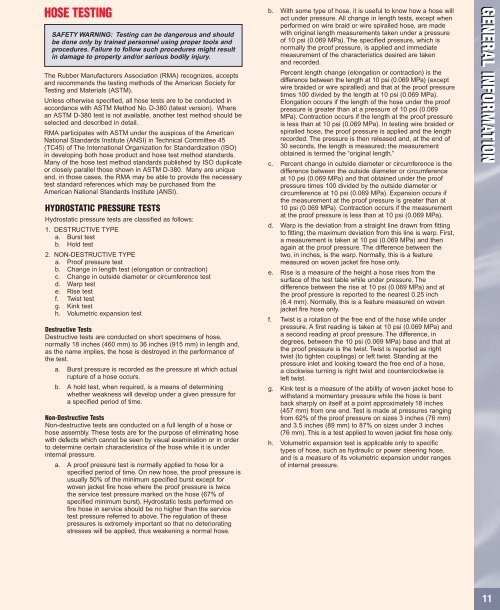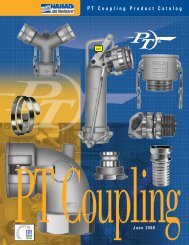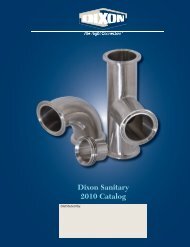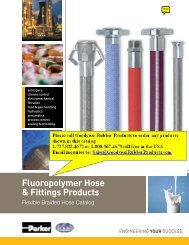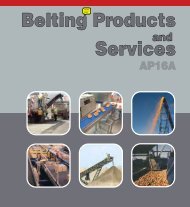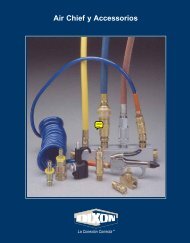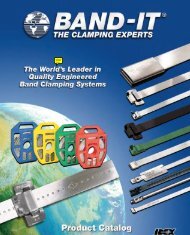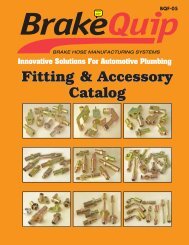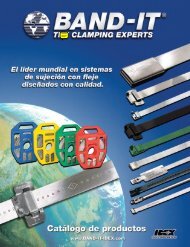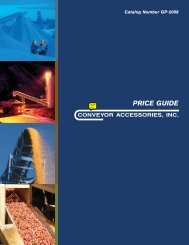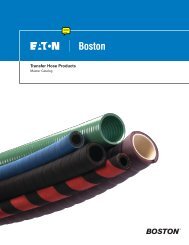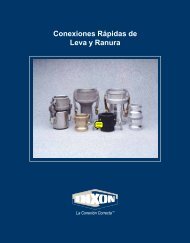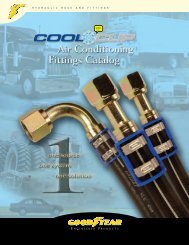HOSE PRODUCTS
Thermoid Industrial Hose Division - Goodyear
Thermoid Industrial Hose Division - Goodyear
- No tags were found...
Create successful ePaper yourself
Turn your PDF publications into a flip-book with our unique Google optimized e-Paper software.
<strong>HOSE</strong> TESTING<br />
SAFETY WARNING: Testing can be dangerous and should<br />
be done only by trained personnel using proper tools and<br />
procedures. Failure to follow such procedures might result<br />
in damage to property and/or serious bodily injury.<br />
The Rubber Manufacturers Association (RMA) recognizes, accepts<br />
and recommends the testing methods of the American Society for<br />
Testing and Materials (ASTM).<br />
Unless otherwise specified, all hose tests are to be conducted in<br />
accordance with ASTM Method No. D-380 (latest version). Where<br />
an ASTM D-380 test is not available, another test method should be<br />
selected and described in detail.<br />
RMA participates with ASTM under the auspices of the American<br />
National Standards Institute (ANSI) in Technical Committee 45<br />
(TC45) of The International Organization for Standardization (ISO)<br />
in developing both hose product and hose test method standards.<br />
Many of the hose test method standards published by ISO duplicate<br />
or closely parallel those shown in ASTM D-380. Many are unique<br />
and, in those cases, the RMA may be able to provide the necessary<br />
test standard references which may be purchased from the<br />
American National Standards Institute (ANSI).<br />
HYDROSTATIC PRESSURE TESTS<br />
Hydrostatic pressure tests are classified as follows:<br />
1. DESTRUCTIVE TYPE<br />
a. Burst test<br />
b. Hold test<br />
2. NON-DESTRUCTIVE TYPE<br />
a. Proof pressure test<br />
b. Change in length test (elongation or contraction)<br />
c. Change in outside diameter or circumference test<br />
d. Warp test<br />
e. Rise test<br />
f. Twist test<br />
g. Kink test<br />
h. Volumetric expansion test<br />
Destructive Tests<br />
Destructive tests are conducted on short specimens of hose,<br />
normally 18 inches (460 mm) to 36 inches (915 mm) in length and,<br />
as the name implies, the hose is destroyed in the performance of<br />
the test.<br />
a. Burst pressure is recorded as the pressure at which actual<br />
rupture of a hose occurs.<br />
b. A hold test, when required, is a means of determining<br />
whether weakness will develop under a given pressure for<br />
a specified period of time.<br />
Non-Destructive Tests<br />
Non-destructive tests are conducted on a full length of a hose or<br />
hose assembly. These tests are for the purpose of eliminating hose<br />
with defects which cannot be seen by visual examination or in order<br />
to determine certain characteristics of the hose while it is under<br />
internal pressure.<br />
a. A proof pressure test is normally applied to hose for a<br />
specified period of time. On new hose, the proof pressure is<br />
usually 50% of the minimum specified burst except for<br />
woven jacket fire hose where the proof pressure is twice<br />
the service test pressure marked on the hose (67% of<br />
specified minimum burst). Hydrostatic tests performed on<br />
fire hose in service should be no higher than the service<br />
test pressure referred to above. The regulation of these<br />
pressures is extremely important so that no deteriorating<br />
stresses will be applied, thus weakening a normal hose.<br />
b. With some type of hose, it is useful to know how a hose will<br />
act under pressure. All change in length tests, except when<br />
performed on wire braid or wire spiralled hose, are made<br />
with original length measurements taken under a pressure<br />
of 10 psi (0.069 MPa). The specified pressure, which is<br />
normally the proof pressure, is applied and immediate<br />
measurement of the characteristics desired are taken<br />
and recorded.<br />
Percent length change (elongation or contraction) is the<br />
difference between the length at 10 psi (0.069 MPa) (except<br />
wire braided or wire spiralled) and that at the proof pressure<br />
times 100 divided by the length at 10 psi (0.069 MPa).<br />
Elongation occurs if the length of the hose under the proof<br />
pressure is greater than at a pressure of 10 psi (0.069<br />
MPa). Contraction occurs if the length at the proof pressure<br />
is less than at 10 psi (0.069 MPa). In testing wire braided or<br />
spiralled hose, the proof pressure is applied and the length<br />
recorded. The pressure is then released and, at the end of<br />
30 seconds, the length is measured; the measurement<br />
obtained is termed the “original length.”<br />
c. Percent change in outside diameter or circumference is the<br />
difference between the outside diameter or circumference<br />
at 10 psi (0.069 MPa) and that obtained under the proof<br />
pressure times 100 divided by the outside diameter or<br />
circumference at 10 psi (0.069 MPa). Expansion occurs if<br />
the measurement at the proof pressure is greater than at<br />
10 psi (0.069 MPa). Contraction occurs if the measurement<br />
at the proof pressure is less than at 10 psi (0.069 MPa).<br />
d. Warp is the deviation from a straight line drawn from fitting<br />
to fitting; the maximum deviation from this line is warp. First,<br />
a measurement is taken at 10 psi (0.069 MPa) and then<br />
again at the proof pressure. The difference between the<br />
two, in inches, is the warp. Normally, this is a feature<br />
measured on woven jacket fire hose only.<br />
e. Rise is a measure of the height a hose rises from the<br />
surface of the test table while under pressure. The<br />
difference between the rise at 10 psi (0.069 MPa) and at<br />
the proof pressure is reported to the nearest 0.25 inch<br />
(6.4 mm). Normally, this is a feature measured on woven<br />
jacket fire hose only.<br />
f. Twist is a rotation of the free end of the hose while under<br />
pressure. A first reading is taken at 10 psi (0.069 MPa) and<br />
a second reading at proof pressure. The difference, in<br />
degrees, between the 10 psi (0.069 MPa) base and that at<br />
the proof pressure is the twist. Twist is reported as right<br />
twist (to tighten couplings) or left twist. Standing at the<br />
pressure inlet and looking toward the free end of a hose,<br />
a clockwise turning is right twist and counterclockwise is<br />
left twist.<br />
g. Kink test is a measure of the ability of woven jacket hose to<br />
withstand a momentary pressure while the hose is bent<br />
back sharply on itself at a point approximately 18 inches<br />
(457 mm) from one end. Test is made at pressures ranging<br />
from 62% of the proof pressure on sizes 3 inches (76 mm)<br />
and 3.5 inches (89 mm) to 87% on sizes under 3 inches<br />
(76 mm). This is a test applied to woven jacket fire hose only.<br />
h. Volumetric expansion test is applicable only to specific<br />
types of hose, such as hydraulic or power steering hose,<br />
and is a measure of its volumetric expansion under ranges<br />
of internal pressure.<br />
GENERAL INFORMATION<br />
11


